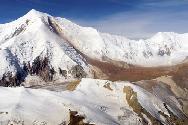Mount Steele, which stands 5,067 metres tall and is the fifth-highest peak in Canada, recently had two slides take place in the same area, on the northern face of the mountain.

|
| ©Peter von Gaza/CP |
| A massive slide of ice and rock on Mount Steele in the Yukon Territory triggered seismic recorders around the world. |
The second slide was by far the larger of the two and occurred on July 24, two days after the original slide.
It was the equivalent of a 3.5-magnitude earthquake and was big enough to generate a seismic signal that could be picked up around the world.
"The first one was still very impressive and terrifying, but the second slide was just massive," said Panya Lipovsky, a geologist for the Yukon Geological Survey.
Ms. Lipovsky flew over the slide area last week to survey the site and see how much it had changed since initial reports.
Using photographs, geologists have been able to estimate the debris spanned about seven kilometres and fell some 2,500 metres to the glacier below.
The debris also covered the Steele glacier, which is a kilometre and a half wide. And it carried up a 300-metre ridge at the far side of the glacier, spilling down another 700 metres onto the neighbouring Hodgson Glacier.
"It was an absolutely massive amount of rock that fell," Ms. Lipovsky said.
At the time, a research team from the University of British Columbia, headed by Garry Clarke, was studying glacier dynamics about 15 kilometres north of Mount Steele.
"They were able to see the original slide on July 22, and I guess they were wondering if they should run for cover, in case the same thing happened where they were," Ms. Lipovsky said.
Members of the research team returned the next day to take pictures, and were still in the region when the major slide occurred.
Studies have now begun to try and determine what caused the slide.
Ms. Lipovsky said it could have been triggered by several factors, including climate change and permafrost degradation, if the bedrock underneath had become weakened by frost shatter.
The slide has generated huge interest from top geologists across Canada, including Stephen Evans of the University of Waterloo.
"Firstly, we're always interested in landslides involving glaciers or glacial ice because they move so fast, and because they've caused fairly substantial disasters worldwide," Prof. Evans said.
"The other reason is because we're trying to find a link between it and climate change."
Prof. Evans conducts research on catastrophic landslides - those that travel more than five metres a second.
"Thanks to glacier melt due to global warming, mountain areas have become more susceptible to changes and stress," he said. "This is a worldwide phenomenon taking place."
On Wednesday night, Prof. Evans was to leave for southern Russia, where he will study a similar slide in the Caucasus Mountains in 2002. That slide, known as the Kolka event, caused debris to travel 17 kilometres at an average speed of 50 metres a second.
In comparison, the fastest lap at the 2007 Hungarian Grand Prix, a Formula One event, was 51 metres per second.
From the data Prof. Evans has seen of the Mount Steele slide, the 300-metre runup at the base of the initial slide and its descent to Hodgson Glacier indicate it had a minimum velocity of 70 metres a second or 252 kilometres an hour.



Reader Comments
to our Newsletter